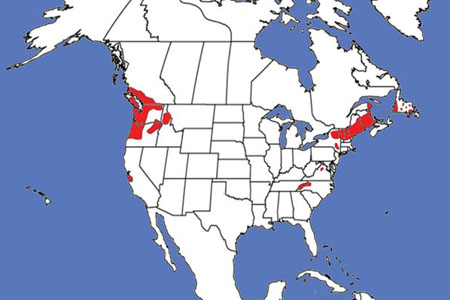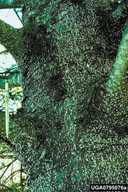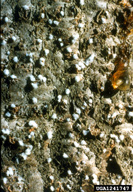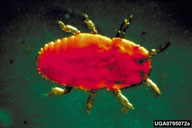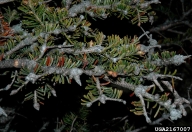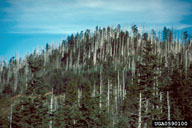Balsam woolly adelgid
Adelges piceae (Ratzeburg) (Hemiptera Adelgidae)
Orientation to pest
Balsam woolly adelgid, Adelges piceae (Ratzeburg), attacks only true firs (Abies). It is native to Eurasia and is a serious invasive pest in both eastern and western North America. Balsam woolly adelgids are small, <1 mm in size, and covered with white, woolly wax. Adults and nymphs feed on both the bole and twigs and inject hormones with their saliva that causes gouty twigs and growth of compression wood on the bole. These deformities disrupt water conduction and reduce tree growth and market value. Heavy infestations eventually kill the tree. Extensive damage to Fraser fir (Abies fraseri [Pursh] Poir.) in the southern Appalachian Mountains caused severe ecological damage to unique mountain-top habitats created by stands of this species. Damage to balsam (Abies balsamea (L.) Mill.) and western firs has caused significant economic losses due to a combination of elevated rates of tree mortality and reduced growth. Various predators imported and released during the 1950s from the European Alps failed to bring the pest under biological control. However, it is possible that the Alps themselves were an invaded area and that the true native range is the Caucasus Mountains. Thus, this region has potential as a source of effective natural enemies for this pest.
Hosts commonly attacked
The host plants of balsam woolly adelgid are Fraser fir (A. fraseri), balsam fir (A. balsamea), subalpine fir (Abies lasiocarpa [Hooker] Nuttall), Pacific silver fir (Abies amabilis Douglas ex J. Forbes), and grand fir (Abies grandis [Douglas ex D. Don] Lindley).
Distribution
Balasm woolly adelgid is found in New York, New England, the Canadian Maritimes, British Columbia, the Pacific northwestern US states, and limited areas of the southern Appalachian Mountains and the central coast of California.
| Figure 1. Distribution of balsam woolly adelgid, Adelges piceae in North America |
Images of balsam woolly adelgid
| Figure 2. Bole of fir tree infested with balsam woolly adelgid, Adelges piceae | Figure 3. Close view of balsam woolly adelgids on bark of fir tree |
| Figure 4. High magnification of crawler (first instar) of balsam adelgid | Figure 5. Goutiness of Fraser fir twigs due to feeding by balsam woolly adelgid | Figure 6. Fraser fir trees killed by balsam woolly adelgid |
Important biological control agents related to this pest species
More than 23 species of natural enemies were imported and released into the United States against this pest. Six species established, but remain rare: Aphidecta obliterata (L.) (Coleop.: Coccinellidae), Scymnus impexus (Mulsant) (Coleop.: Coccinellidae), Laricobius erichsonii (Rosenhauer) (Coleop.: Derodontidae), Aphidoletes thompsoni Möhn (Diptera: Cecidomyiidae), Cremifania nigrocellulata Czerny (Diptera: Chamaemyiidae), and Leucopis obscura (Hal.) (Diptera: Chamaemyiidae).
Web links for information on balsam woolly adelgid
- Forest Insect & Disease Leaflet 118 | USDA Forest Service
- Christmas Tree Note | North Carolina Cooperative Extension
- Bulletin | Virginia Polytechnic Institute and State University
Provides information for control in Christmas tree plantations and forest situations
Articles
- Harris, J. W. E. and A. F. Dawson. 1979. Predator release program for balsam woolly aphid, Adelges piceae (Homoptera: Adelgidae), in British Columbia, 1960-1969. Journal of the Entomological Society of British Columbia 76: 21-26.
- Schooley, H. O. and L. Oldford. 1981. An annotated bibliography of the balsam woolly aphid (Adelges piceae [Ratzeburg]). Information Report N-X-196, Canadian Forestry Service, 97 pp.
- Schooley, H. O., J. W. E. Harris, and B. Pendrel. 1984. Adelges piceae (Ratz.) balsam woolly adelgid (Homoptera: Adelgidae), pp. 229-234. In: Kelleher, J. S. and M. A. Hulme (eds.). Biological Control Programmes against Insects and Weeds in Canada, 1969-1980. Commonwealth Agricultural Bureaux, Farnham Royal, England.
- McManamay, R. H., L. M. Resler, J. B. Campbell, and R. A. McManamay. 2011. Assessing the impacts of balsam woolly adelgid (Adelges piceae Ratz.) and anthropogenic disturbance on the stand structure and mortality of Fraser fir [Abies fraseri (Pursh) Poir.] in the Black Mountains, North Carolina. Castanea 76 (1): 1-19.
